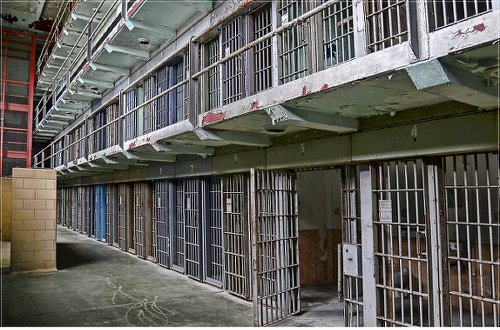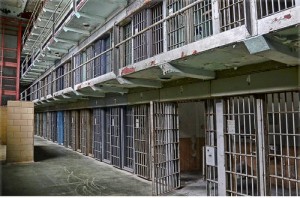

“Mass incarceration on a scale almost unexampled in human history is a fundamental fact of our country today — perhaps the fundamental fact, as slavery was the fundamental fact of 1850.” (“The Caging of America” by Adam Gopnik)


Then why is it so hard to stop?
Because for a very powerful few, mass incarceration is not a bad thing at all. It is the source of fabulous profits. For them, prison equals profits.
The total cost to government of incarceration is $70 billion a year. The privately run prison industry, which feeds on mass incarceration, is one of the fastest growing and widest reaching of U.S. industries. In 2009 alone, when most industries were in a slump, the prison industry brought in $34.4 billion in revenues. (“Prison Labor and Crime in the U.S. — Inmate Facts and Stats,” a report to the Black Congressional Caucus at www.phewacommunity.org)
The rate of profits from prison industries is comparable to what U.S. companies extract from exploiting labor markets in the global South, without the need to pay the added transportation costs. There is virtually no overhead for these corporations, because the prisons are paid for and prisoners are housed at tax dollar expense.
Secret corporate cheerleaders of mass incarceration
This is why some of the world’s most powerful financial institutions — Bank of America, Goldman Sachs Group, JPMorgan Chase & Co. and others — are the primary investors in the prison-industrial complex and the secret cheerleaders of mass incarceration.
That’s why virtually every major company and employer — from the U.S. military to Exxon, to McDonalds, to Victoria’s Secret — and a great many minor ones, profit directly or indirectly from low-cost prison labor. This reach is so vast that the products of prison labor touch virtually every part of life, from the food we eat, the jeans we wear, the phones we use, to how our pensions are invested.
That’s why the judiciary, the courts, the police, the legislatures and even whole federal agencies have become apologists for, encouragers of and accomplices in punishment for profit, having had their palms amply greased by its main corporate players.
Legislation that enables financial gain from prisons, such as mandated harsh sentences for nonviolent crime, were actually written by the prison profiteers, then passed by legislatures in their pay.
Prison labor has taken the place of many jobs. So punishment for profit contributes to unemployment, undermines workers’ demands for living wages and creates obstacles to trade union organizing.
How did this happen?
Emergence of the prison-industrial complex
The term “prison-industrial complex” was coined in 1997 by activist and former political prisoner Angela Davis to describe the high rate of profit made by the corporations running prisons, the merger of these companies with the biggest banks and businesses, and the devastating effect this phenomenon has had upon the working class, communities of color and the socially vulnerable.
Before 1980, there were no private adult prisons in the U.S. Private companies began to run state and federal prisons in the 1980s, under President Ronald Reagan. These corporations were given a huge boost in the 1990s by President William Clinton, whose cut to government jobs provided a golden opportunity for private firms seeking to run prisons. “Punishment for profit” was off and running.
Since then, there has been an explosion in private companies providing goods and services to government agencies involved in punishment. This includes contract prison labor, construction of prisons, surveillance, tech vendors, prison food providers, medical services, phone service for prisoners, private probation companies, investors in these companies, and the lobbyists that represent the businesses seeking to expand the prison system.
Revenues increased 500 times
Two of the largest private companies now running prisons are the Correction Corporation of America (CCA) and the GEO Group. There were no private prisons before 1984. From then until 2009, these two corporations increased their role to running 264 prisons with more than 100,000 prisoners. (“Prison Labor and Crime in the U.S.”) The CCA’s revenues increased 500 times in the last two decades. (Mother Jones, Sept. 19, 2013)
Then there’s the work that inmates do inside the institutions. Prisoners toiling often for pennies an hour and sometimes without any pay at all, totaled at least $2.4 billion in sales, and maybe as much as $5 billion. (www.phewacommunity.com)
The private companies get a cheap, easy labor market, where they don’t have to provide benefits or sick days, there is no union organizing, and if a person refuses to work they can be locked in solitary confinement.
We pay the overhead!
These businesses have virtually no overhead costs in the prisons because the cost of incarceration and the source of their cash-cow profits are tax dollars.
While money is steadily cut from social programs, tax subsidizing of prison profiteers does not come cheap. The Vera Institute for Justice states in its report, “The Price of Prisons,” that the cost to taxpayers of incarcerating one inmate in fiscal 2010 was $31,307 per year, and in Connecticut, Washington state and New York,” It’s anywhere from $50,000 to $60,000.”
The American Civil Liberties Union reveals that the national yearly figure for incarcerating people with mental illness, a vulnerable population jailed at disproportionately high rates and suffering greatly in jail, is more than $63,000 a year. (ACLU report, July 2014, tinyurl.com/mng4ya2) All of this is paid for by U.S. workers.
Some 600,000 to 1 million of the 2.4 million U.S. prisoners toil in 300 factories in a 21st century form of slavery. (www.phewacommunity.com) El Diario-La Prensa of March 10, 2008, writes that the companies contracting private prison labor contain “the cream of U.S. corporate society: IBM, Boeing, Motorola, Microsoft, AT&T, Wireless, Texas Instrument, Dell, Compaq, Honeywell, Hewlett-Packard, Nortel, Lucent Technologies, 3Com, Intel, Northern Telecom, TWA, Nordstrom’s, Revlon, Macy’s, Pierre Cardin, Target Stores and many more.” The whole capitalist establishment is in on it.
A system ‘too vast to boycott’
Bob Sloan, who wrote the “Prison Labor and Crime in the U.S.” report, unearths and exposes businesses involved in prison labor. He found that McDonald’s uniforms are made in jail. Kmart and J.C. Penny sell jeans sewn by inmates in Tennessee. (www.dailykos.com, Dec. 13, 2010).
And then there’s food production. In July/August 2008, Mother Jones magazine reported that in California alone, prisoners were processing “more than 680,000 pounds of beef, 400,000 pounds of chicken products, 450,000 gallons of milk, 280,000 loaves of bread, and 2.9 million eggs.” Signature Packaging Solutions, a Starbucks subcontractor, was using prisoners to package holiday coffees.
Inmates are producing airplane parts, medical supplies and much more. They are even raising seeing-eye dogs.
Investors in prison labor and the prison-industrial complex include the oil giants ExxonMobil Corp. and Chevron, Koch Industries, a host of utility companies, and insurance companies such as GEICO, State Farm and Fidelity Investments, which holds the 401(k) and retirement counts of millions of people, according to Sloan.
Involved in punishment for profit are a host of giant pharmaceutical companies, including Bayer, Glaxo Wellcome, Merck & Co. and Pfizer. Also making gain from the misery of those behind bars are Caterpillar Inc., International Game Technology, virtually all the telecommunications companies, and transportation companies such as American Airlines, Boeing and United Parcel Service, says Sloan. So the hotel and airline reservations we make for vacations are often handled by prisoners. And this is just a sampling.
Sloan concludes, “The Prison-Industrial Complex is simply too vast to avoid or boycott — in a manner typically used by consumers and concerned citizens.”
To get your job back ‘go to prison’
Factories are closing and workers being laid off because it’s cheaper for the bosses to get prisoners to do the work.
In Texas, a factory fired its 150 workers and contracted the service of prison-workers from the private Lockhart Correctional Facility in that state, where circuit boards are assembled for companies like IBM and Compaq.
The federal government is in on this, too. It owns Federal Prison Industries, operating in 83 federal prisons and employing more than 13,000 inmates at from $0.23 to $1.15 an hour. FPI collected more than $900 million in revenue in 2011. It produced more than $100 million in military uniforms in 2012. (“More Jobs Lost as the Government Decides to Have Military Uniforms Made by Convicts,” Business Insider, Sept. 7, 2012)
In 2012, Tennier Industries fired more than 100 employees after losing its military uniform contract to FPI. That year, American Apparel closed an Alabama plant employing 175 for the same reason. The workers there had made $9 an hour, and had benefits.
A disgruntled Kurt Courtney, director of government relations at American Apparel, told CNN on Aug. 14, 2012, “The only way for workers to get jobs back is to go to prison.”
U.S. prison labor is even replacing labor markets in poor and oppressed countries. A company that operated a maquiladora (the Spanish term used for a foreign-owned assembly plant on the Mexican side of the U.S./Mexico border) closed down its operations there and relocated to San Quentin State Prison in California. “[Former] Oregon State Representative Kevin Mannix recently urged Nike to cut its production in Indonesia and bring it to his state, telling the shoe manufacturer that ‘there won’t be any transportation costs; we’re offering you competitive prison labor (here),” according to the El Diario article.
Prisoners replacing farmworkers
Fruits and vegetables are often picked by immigrants, many of them undocumented. The Obama administration, however, has deported undocumented workers in record numbers, while it slowed the legal flow of contracted agricultural workers into the country. At the same time, more states are issuing fines to farmers and agricultural businesses who hire undocumented workers.
With fewer workers available to pick crops at the going wage, the prison-industrial complex has happily stepped in to fill the gap. Today, prisoners pick onions in Georgia, watermelons in Arizona, apples in Washington and potatoes in Idaho.
For a capitalist, what’s not to like?
Profiting from people in jail is undeniably a horrible form of exploitation, destructive to all working people and to society as a whole. This is the raw face of capitalism in the 21st century, without the ideological touch ups provided by Wall Street public relations firms or the corporate media.
The drive for ever greater profits is built into the capitalist system. Money gravitates to where the rate of profit is the highest, regardless of the social cost. This is why virtually all the corporate establishment sharks are in a feeding frenzy over the profits to be made off of punishment.
For a capitalist, what’s not to like?
Next: The terrible human toll. How do the prison profiteers get away with it?
Desde que la administración de Donald Trump/Elon Musk tomó las riendas del poder a finales…
Philadelphia Palestine activists marched from Philadelphia City Hall to Day & Zimmermann on April 18…
Marching up Blue Hill Avenue. through the Black and immigrant Dorchester neighborhood, Trans Day of…
This statement was recently issued by over 30 groups. On Friday, March 28, Dr. Helyeh…
By Jeri Hilderley I long for peace and ease as stress and anxiety overtake me.…
Los siguientes son extractos de la declaración del Gobierno de Nicaragua del 9 de abril…